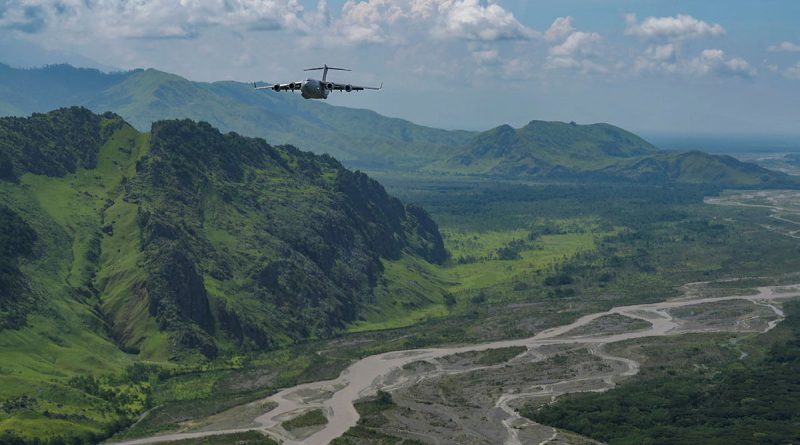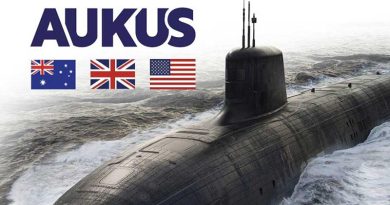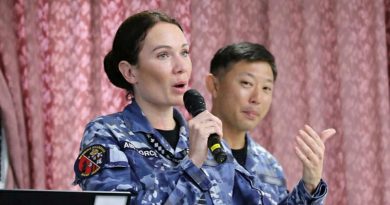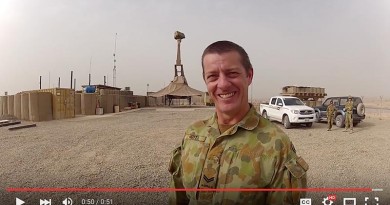Skilled aviators master tricky terrain

Flying in the valleys of Papua New Guinea has provided a unique challenge for American and Australian aviators during Exercise Global Dexterity 22-2.
CAPTION: A RAAF C-17 Globemaster III flies in a 2-ship formation with a US Air Force C-17 over Papua New Guinea. Story by By Flight Lieutenant Tanya Carter. Photo by Staff Sergeant Alan Ricker.
On November 18, a pair of C-17A Globemaster III transport aircraft took off from RAAF Base Scherger in far northern Queensland for the six-hour mission.
The aircraft – one from the Royal Australian Air Force (RAAF), the other from the United States Pacific Air Forces (PACAF) – conducted simulated airdrops in formation over Papua New Guinea.
The colossal C-17A is capable of airdropping everything from rations and water through to bulldozers and other engineering equipment.
Flight Lieutenant Matthew Huber, a C-17A pilot with the RAAF’s 36 Squadron, said it was the first time RAAF and PACAF C-17A crews had conducted this training in Papua New Guinea.
“Papua New Guinea provided a unique environment for flying training, with high terrain and challenging environmental conditions unlike anywhere in the immediate Indo-Pacific region,” Flight Lieutenant Huber said.
“The C-17A is an extremely versatile and manoeuvrable aircraft for its size, and conducting this training in Papua New Guinea provided the crews from both countries a unique experience.”
Major Joshua Moore, PACAF 15th Wing Director of Agile Combat Employment, said he was grateful to have flown on Exercise Global Dexterity.
“It was truly one of those once-in-a-lifetime kind of experiences,” Major Moore said.
“It was awesome to be able to fly in that beautiful and rugged terrain and to do so operating seamlessly in an integrated crew.”

CAPTION: A RAAF C-17 Globemaster III flies in a 2-ship formation with a PACAF C-17 during Exercise Global Dexterity in the skies over Papua New Guinea. Photo by Staff Sergeant Alan Ricker.
Exercise Global Dexterity is held twice a year, with hosting duties rotating between the PACAF’s 535th Airlift Squadron in Hawaii, and RAAF’s 36 Squadron at RAAF Base Amberley near Brisbane.
The latest iteration of the exercise, from November 14 to 18, included low-level missions across NSW and Queensland.
The exercise tests RAAF and PACAF workforce integration, demonstrating both units’ ability to operate and maintain C-17As together.
“Any time you fly low level in an unfamiliar area, especially in formation, it requires a high level of crew coordination, route planning, briefing, and study,” Major Moore said.
“It also requires a high degree of trust in the person sitting next to you and their capabilities as an aviator.
“Everyone has to be on the same page with the same verbiage, and understanding the same meaning with every word.”
Commanding Officer 36 Squadron Wing Commander Dean Bolton said missions included air-to-air refuelling, tactical formation flying, low-level navigation, personnel airdrop and aerial cargo delivery.
“The opportunity to integrate with the 535th AS strengthens our relationship, validates our unilateral training and ultimately sharpens our collective readiness to operate effectively alongside PACAF,” Wing Commander Dean Bolton said.
“The United States and Australia both use the C-17A to deliver critical supplies throughout the Indo-Pacific, often at short notice.
“This includes supporting humanitarian assistance and disaster relief operations, where a C-17A can land with relief cargo or large vehicles essential for recovery efforts; or airdrop cargo and supplies to a drop zone if no runway is available.
“We thank the Papua New Guinea community for their support in facilitating this important training.”
.
.

.
.





